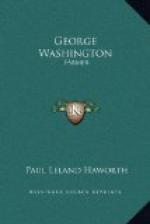Long before this he had begun to gather fruits from his early trees and vines. Being untroubled by San Jose scale and many other pests that now make life miserable to the fruit grower, he grew fine products and no doubt enjoyed them.
His esthetic sense was not yet fully developed, but he was always desirous of having his possessions make a good appearance, and by 1768 was beginning to think of beautifying his grounds. In that year he expressed a wish that he later carried out, namely to have about his mansion house every possible specimen of native tree or shrub noted for beauty of form, leaf or flower.
Even amid the trials of the Revolution this desire was not forgotten. In 1782 he directed Lund Washington, his manager, to plant locusts and other ornamental trees and shrubs at the ends of the house. He wrote that such trees would be more likely to live if taken from the open fields than from the woods because the change of environment would be less pronounced. To what extent the work was carried I have been unable to ascertain, for, as elsewhere stated, very little of his correspondence with his manager during these years survives.
He returned from the Revolution with a strong desire to beautify his estate, a desire in part due no doubt to seeing beautiful homes elsewhere and to contact with cultured people, both Americans and foreigners. One of his first tasks was to rebuild and enlarge his house. From a small house of eight rooms he transformed Mount Vernon into the present large mansion, ninety-six feet and four inches long by thirty-two feet in depth, with two floors and an attic, an immense cellar and the magnificent portico overlooking the Potomac. The plans and specifications he drew with his own hands, and those who have visited the place will hardly deny that the mansion fits well into its setting and that, architects tell us, is a prime consideration. The flagstones for the floor of the portico he imported from Whitehaven, England, and these still remain in place, though many are cracked or broken.
The portico runs the entire length of the house, is over fourteen feet deep and its floor is one hundred twenty-four feet ten and one-half inches above high water-mark, according to calculations made by Washington himself. From it one commands miles of the Potomac and of the Maryland shore and there are few such noble prospects in America. Washington owned a telescope and spy glasses and with them could watch the movements of ships and boats on the river. The portico was a sort of trysting place for the family and visitors on summer afternoons and evenings, and some of the thirty or so Windsor chairs bought for it are still in existence.
[Illustration: West Front of Mansion House, Showing Bowling Green and Part of Serpentine Drive]
[Illustration: Experimental Plot, with Servants’ Quarters (restored) in Background]




